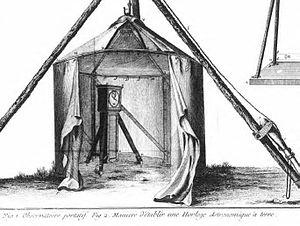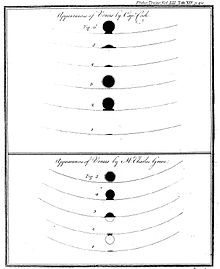1769 transit of Venus observed from Tahiti

On 3 June 1769, navigator Captain
Background

In 1663, Scottish mathematician
The viewing of the 1761 transit involved the effort of 120 observers from nine nations.[7] Thomas Hornsby reported the observations as unsuccessful primarily due to poor weather conditions. He alerted the Royal Society in 1766 that preparations needed to begin for the 1769 transit.[8] Hornsby's publication in the Philosophical Transactions of the Royal Society in 1766 focused attention on the "cone of visibility" indicating, like Halley, some of the better places to observe the transit.[8] The Royal Society boasted that the British "were inferior to no nation on earth, ancient or modern" and were eager to make another attempt.[9]
When choosing a location for viewing the transit, The Royal Society basically chose the locations Halley suggested in his 1716 article. The committee recommended that the transit be observed from three points: the
Choosing an island, a ship and a Captain
In June 1767 British navigator
Preparation for the transit
Once the Endeavour arrived on the island, Cook decided to set up the Venus transit
The day of the transit

The observers were ordered to record the transit in four phases of Venus' journey across of the sun. The first phase was when Venus began "touching" the outside rim of the sun. In the second phase, Venus was completely within the sun's disc, but was still "touching" the outer rim. In the third phase, Venus has crossed the sun, was still completely within the disc, but was "touching" the opposite rim. Finally in the fourth phase, Venus was completely off the sun, but was still "touching" its outer rim.[2]
On the day of the transit, the sky was clear. Independent observations were made by James Cook, Green and Solander with their own telescopes.[1] Because of the rarity of the event, it was important to take accurate records. The next transit would not occur for more than a century, in 1874.[15]
In his journal, Cook wrote:
This day prov'd as favourable to our purpose as we could wish, not a Clowd was to be seen the whole day and the Air was perfectly clear, so that we had every advantage we could desire in Observing the whole of the passage of the Planet Venus over the Suns disk: we very distinctly saw an Atmosphere or dusky shade round the body of the Planet which very much disturbed the times of the Contacts particularly the two internal ones. Dr. Solander observed as well as Mr. Green and my self, and we differ'd from one another in observeing the times of the Contacts much more than could be expected. Mr Greens Telescope and mine were of the same Magnifying power but that of Dr was greater than ours.[16]
Recording the exact moment of the phases proved to be impossible due to a phenomenon called the "
Results of the 1769 transit observations

The Royal Society was very disappointed in the results of data collected from the transit and Cook's report. The Tahiti observers had trouble with the timing of the stages and their drawings were inconsistent. They later found out that this was also true with the observers at the other locations. Observers from all over noted a haze or "black drop" that seemed to follow Venus making it very difficult to record time entry point on the sun and the exit from the sun.[2]
For what they believed to be a failure in the observation, The Royal Society decided to blame Green who died on the voyage back to England. Cook's rebuke was so sharp that it was struck from the official proceedings of the Society. Green was not given the opportunity to personally present his own data nor could he defend himself.[2]
Scientific community
Halley's 1716 article called for observers to witness the transit at various places on the globe. The response from the
Modern results compared to results from the 1769 transit
Using the solar parallax values obtained from the 1769 transit, the astronomer
References
- ^ a b Rienits & Rienits 1976, p. 39.
- ^ a b c d e Herdendorf 1986.
- ^ Rienits & Rienits 1976, p. 28.
- ^ London Missionary Society, ed. (1869). Fruits of Toil in the London Missionary Society. London: John Snow & Co. p. 12. Retrieved 12 September 2016.
- ^ Teets 2003, pp. 335–348.
- ^ Halley 1716.
- ^ a b Rice 2008.
- ^ a b Williams 2004.
- ^ a b Rienits & Rienits 1976, p. 24.
- ^ MacLean 1974, p. 37.
- ^ a b Rienits & Rienits 1976, p. 25.
- ISSN 0261-0523.
- ^ MacLean 1974, p. 54.
- ^ MacLean 1974, p. 55.
- ^ Teets 2003, p. 335.
- ^ Beaglehole 1999.
- ^ Pasachoff et al. 2004, p. 6.
- ^ Teets 2003, p. 338.
- ^ a b Teets 2003, p. 347.
- ISBN 978-0-85115-744-3.
- Crosland, Maurice (22 January 2005). "Relationships between the Royal Society and the Academie des Sciences in the late eighteenth century". Notes and Records of the Royal Society. 59 (1): 30. S2CID 71641646.
- Halley, Edmund (1716). "A New Method of Determining the Parallax of the Sun". Philosophical Transactions of the Royal Society. XXIX: 454. .
- Herdendorf, Charles (January 1986). "Captain James Cook and the Transits of Mercury and Venus". Journal of Pacific History. 1. 21: 39–55. .
- MacLean, Alistair (1974). Captain Cook. London: Fontana. ISBN 978-0-00-653646-8.
- Pasachoff, Jay; Schneider, Glenn; Golub, Leon (2004). "The Black-Drop Effect Explained". Proceedings IAU Colloquium. 196.
- Rice, Tony (2008). Voyages of discovery : a visual celebration of ten of the greatest natural history expeditions. Richmond Hill, Ont.: Firefly Books. ISBN 978-1-55407-414-3.
- Rienits, Rex; Rienits, Thea (1976). The voyages of Captain Cook. London: Hamlyn. ISBN 978-0-600-04111-5.
- Teets, Donald (December 2003). "Transits of Venus and the Astronomical Unit" (PDF). Mathematics Magazine. 76 (5): 335–348. S2CID 54867823.
- Williams, Glyndwr, ed. (2004). Captain Cook : explorations and reassessments (first ed.). Rochester, N.Y.: Boydell Press. ISBN 978-1-84383-100-6.
